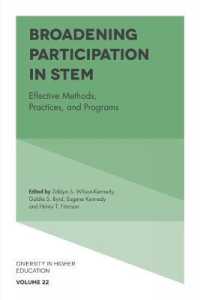- ホーム
- > 洋書
- > 英文書
- > Science / Mathematics
基本説明
ランダムネットワークの技術や課題についてまとめた院生・科学者向けの入門書。
Focus on information flow the issue at the heart of communication systems.
Full Description
When is a random network (almost) connected? How much information can it carry? How can you find a particular destination within the network? And how do you approach these questions - and others - when the network is random? The analysis of communication networks requires a fascinating synthesis of random graph theory, stochastic geometry and percolation theory to provide models for both structure and information flow. This book is the first comprehensive introduction for graduate students and scientists to techniques and problems in the field of spatial random networks. The selection of material is driven by applications arising in engineering, and the treatment is both readable and mathematically rigorous. Though mainly concerned with information-flow-related questions motivated by wireless data networks, the models developed are also of interest in a broader context, ranging from engineering to social networks, biology, and physics.
Contents
Preface; 1. Introduction; 2. Phase transitions in infinite networks; 3. Connectivity of finite networks; 4. More on phase transitions; 5. Information flow in random networks; 6. Navigation in random networks; Appendix; References; Index.








